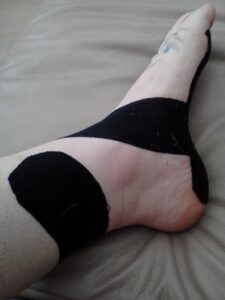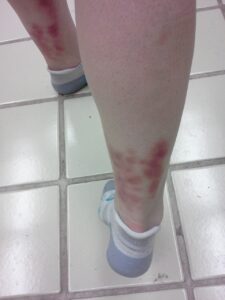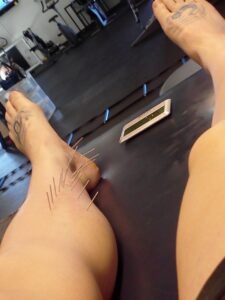
When I finished the 2013 Rock ‘n’ Roll Half Marathon, I had excruciating pain in both shins and feet. I was pretty sure I had multiple stress fractures from shin splints and plantar fasciitis. My coach suggested I do some work on my running form before my next race to prevent these injuries from recurring. I thought he meant I should take a half-day interactive running seminar. I had no idea that I needed 10 weeks of physical therapy.
My physical therapist, Eric, filmed me running on the treadmill, from behind and from the side, with and without shoes. He showed me the footage in slow motion which clearly showed that I had a heel striking problem and that my hips were uneven when I took a step with my left foot. I had no kick on the back side of my stride, and I was barely picking up my feet, (which explains why I frequently trip on cracks in the sidewalk).
My physical therapy regimen included stretching, exercises to strengthen my legs, and ASTYM to break up the scar tissue in my lower legs. We also did exercises on proper running posture. It feels kinda dorky to practice going through the motions of running without actually running.
Once we got the scar tissue mostly broken up, I got to practice running with the new form. Eric started me on the Alter-G treadmill – it’s a treadmill with a built-in air bubble. I love this thing. It’s a great device for practicing new running form because you tell it how much of your weight you want to run on. He started me on 60% of my body weight and each session increased it by 10%. It gave me a chance to practice running on my toes without pounding on my joints.
The best part of running on the Alter-G treadmill was I was literally zipped into the air bubble so I couldn’t fall down when I tripped – and I tripped a lot. When we switched me the regular treadmill, I was petrified of tripping over my feet and falling – which thankfully didn’t happen.
After a few weeks of treadmill running, Eric finally cleared me to run in the real world again – just for a few miles. Eric told me to alternate between using the old running form and the new running form – one minute stretches of each – which I thought was weird until I started to run. Holy crap it hurt to run with the new form. I don’t think I’d really used my calves to run long distance before. Switching between the old form and new form gave those muscles a chance to rest a bit.
I worked up to running 3 miles every other day. I started giving equal time to the old form and new form and I’m slowly increasing the amount of time on the new form and decreasing how long I run on the old form. The new form is way more effective and doesn’t put as much pressure on my joints.

Eric’s re-checked my posture both visually and by videotaping me again and tweaked my new form a few times. He said I needed to kick more with my hamstrings on the back side of each stride. It feels like I’m trying to kick myself in the butt with each step, but I’m sure it looks normal to anyone watching. When my arch started hurting, he told me to stop pointing my feet when I run. I’m not used to picking my feet up and I think they’re reaching for the ground a bit, plus I was a gymnast for 17 years so pointing my toes is natural. Relaxing my foot is helping give me more of a mid-foot strike, and decreasing the pain in my arch. And thank goodness for that because Eric’s been massaging the crap out of it, which is excruciatingly painful. When he works on it, I grip the pillow and utter “Jesus Christ†and “Fuck†through clenched teeth.
It’s so weird and mentally taxing to run – thinking about relaxing my foot on the front end and kicking my butt on the back side. I expect it will take years for my new running form to feel normal. It still hurts to run with the old form and new form but that will get better with time. I’m curious to see what this will do for my race time. My half marathon PR is 1:52 and that was with bad form and pain in both feet and shins. I’d love to see how much I improve with proper running posture.

